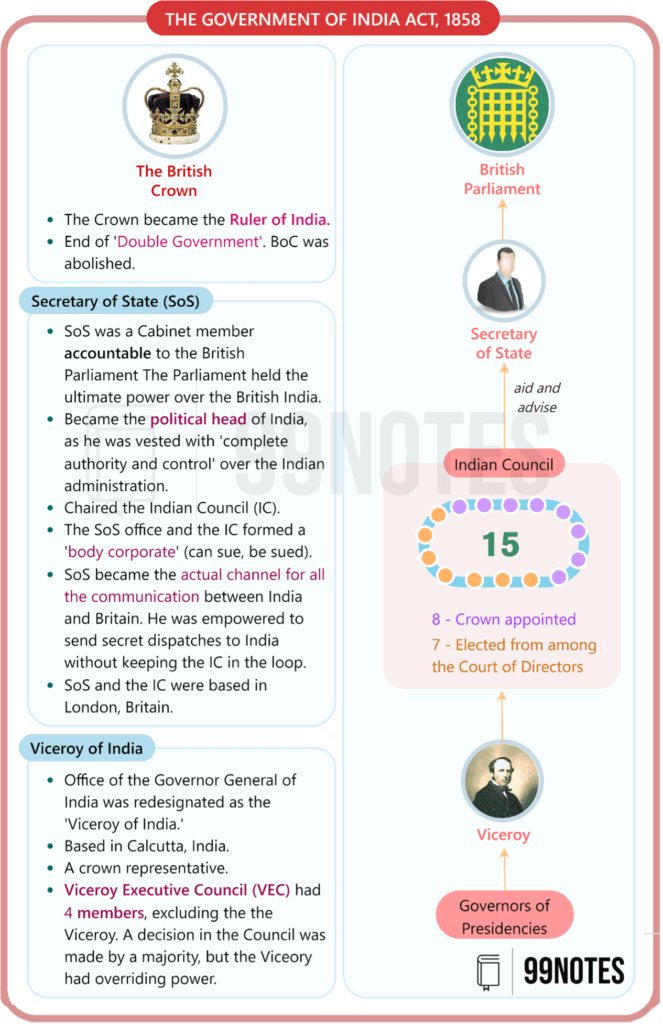THE CROWN RULE (1858-1947)
The Crown Rule refers to the British Raj or Direct rule in India. It was the time when the British power in India shifted from the East India Company to the British Crown. The Crown’s control over the Indian subcontinent from 1858 to 1947.
Since the Pitts India Act of 1784, the British parliament curtailed the power of the Company and eventually brought the Government in India under the British Crown. The whole process was completed with the Government of India Act 1858.
Government of India Act of 1858:
Background:
- The Government of India Act or the Act for the Good Government of India was passed after the Revolt of 1857, also referred to as the First War of Independence or the ‘Sepoy Mutiny’.
- The British Parliament had been looking to take control over India; the Sepoy Mutiny gave them the excuse to do so.
- The 1858 Act led to the dissolution of the East India Company. It transferred government powers, territories, and revenues to the British Crown, making it a pivotal moment in Indian history.
Features of this Act:
- It ended the Dual government scheme that was initiated by the Pitt’s India Act.
- The Company’s Court of Director’s powers were transferred to the Secretary of State for India. He was going to be a member of the British Parliament. He was provided with an advisory body consisting of 15 members.
- The secretary of state-in-council was made into a corporate entity with the ability to initiate and defend legal actions in India and England.
- A viceroy would be appointed to serve as the British Crown’s representative. Lord Canning was the first such Viceroy.
- India became a direct British colony through the passage of this Act.
- The Act ended the controversial ‘Doctrine of Lapse.’
- The Indian Civil Services was to be constituted for the country’s administration. There was also a provision for Indians to be admitted to the service.
- Indian princes were allowed to retain their principalities so long as they accepted the suzerainty of the British.

Criticism of the Act:
- It did not in any way alter the system of Government in India.
- Most of the provisions were enacted to safeguard the jewel of the British empire against any future threats or rebellions.
Indian Councils Acts
- Following the 1857 revolt, the British Government recognised the need to involve Indians in the administration of their country and sought their cooperation.
- The British Parliament passed three acts in 1861, 1892, and 1909 to implement their association policy. The Indian Councils Act of 1861 is important in India’s constitutional and political history.
Indian Councils Act 1861:
The Indian Councils Act of 1861 was an Act of the Parliament of the United Kingdom that transformed India’s executive Council to function as a cabinet run on the portfolio system. It was introduced because the British Government wanted to involve the Indian people in law-making. This Act was passed on August 1, 1861.
Features of the Act of 1861:
- It made the beginning of representative institutions by associating Indians with law-making.
- Viceroy nominated some Indians as non-official members of his expanded Council.
- Lord Canning nominated – the Raja of Benaras, the Maharaja of Patiala and Sir Dinkar Rao.
- Provincial Legislative powers restored:
- Restored legislative powers of Bombay and Madras.
- Establishment of new Legislative councils for North-Western Frontier Province, Punjab and Bengal.
- Viceroy could make provisions for convenient transactions of the business in the Council.
- It gave recognition to the ‘portfolio system’ of Lord Canning.
- The Viceroy could issue ordinances without the concurrence of the Council during an emergency. However, the life of such an ordinance was six months.

Related FAQs of THE CROWN RULE (1858-1947)
The Crown Rule refers to the period from 1858 to 1947 when India was directly ruled by the British Crown, after the transfer of power from the East India Company through the Government of India Act, 1858.
The Act ended Company rule, transferred powers to the British Crown, introduced the post of Secretary of State for India, appointed a Viceroy, and formally brought India under direct British control.
The Act introduced the concept of associating Indians in law-making, restored legislative powers to Bombay & Madras, and recognized the portfolio system in governance under the Viceroy’s executive council.
The Act introduced provincial autonomy, a federal structure (never implemented fully), division of powers between Centre and Provinces, bicameral legislatures, communal electorates, and establishment of RBI and Federal Court.
The Act partitioned British India into two dominions—India and Pakistan, abolished British sovereignty, empowered Indian Constituent Assemblies, and officially ended colonial rule in India on 15th August 1947.







